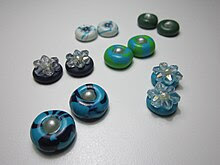Ronnee Strickland — What can we do with polymer clay?
Polymer products can be utilized with a large variety of techniques:
- Sculpting
- Sculpting with polymer clay can be sculpted the same way as ceramic and mud clays and any other physical materials which allow this technique.
Before you cure your polymer clay in a kitchen over (see packaging for correct temperature), you can add glass beads or wire and other objects which do not burn at 275 degrees F. Artists may also use armature wire to support their sculptures. Aluminum foil can prop up large areas, scrunching it into a shape you wish and then covering it with clay. This allows a lighter item and something which is much less expensive to complete. You can build your objects up from other nonflammable objects.
- Marbling and color mixing
- the colors can be mixed while soft, then baked. By mixing two or more colors, then twisting, folding, bending, and cutting, assorted marbled surfaces can be obtained.
There are now literally 100s of premixed colors and you can take any two or more, twist together to get a marble effect. Don’t twist and mix too much or you will have an entirely new color.
- Caning
- Caning or caneworking, also known as millefiori, draws from a traditional glass technique where a two dimensional design is constructed in three dimensions, with the different colored elements of the design extending all the way through the form from the front surface to the back surface. Once the initial form is completed, the form, known as a "cane," can be sliced (with the blade held parallel to the front surface) to produce a number of nearly identical copies of the design. Additionally, the form can be extended by squeezing or rolling the sides so that the form becomes longer from front to back, while becoming narrower in the other two dimensions. When the resulting form is sliced, the original design will be preserved, but lessen to a smaller size. This technique also allows a larger number of slices to be extracted from the same amount of clay. In glass work, the type of the material dictates that these be round, but with polymer clay the shapes can be more varied, although round and square canes are the most common because they are easiest to extend. Cylinders can be rolled out to a longer length very easily, while cubic forms can be squeezed on their four side surfaces. More complex shapes such as hexagons can be worked with, but it is difficult to extend complex shapes without distortion.
- Bull's eye cane
- The process used to create "lacework" with Polymer clay. This refers to a single color roll of Polymer clay, which is then wrapped in a secondary color. Rolling and compressing the two colors to make a perfect join is a known as a "bull's eye". Cutting this length of clay into even lengths and laying them on top of each other and re-rolling forms lacework.
- Beading
- Polymer clay can be formed into beads or charms, with the holes punched before baking or drilled in afterwards.
- Polishing
- Using 400-600 Wet and Dry Sandpaper, an artist can sand their project to create an extremely smooth polished effect. Whilst sanding, a small amount of water should be run over the cured project until desired effect is achieved. A hand-held drill such as a "Dremel" can also be used on a low-speed setting with a buffer pad, to create a more highly polished design.
- Mixed Media
- Polymer clay also works well with Embossing Powders. Mixing them into Fimo clay can create a metallic marble effect. Glitter foil, powders or fragments can be mixed in to create attractive effects when using the Fimo Translucent colors.
- What then?
- Lacquer
- Staedtler produced and sold Fimo-branded glossy lacquer, it has now been discontinued. The lacquers are thick liquids applied after baking. They dry to a hard finish that protects the clay as well as changing the surface texture. A matte finish lacquer was available for some portion of the 1980s and 1990s, but it has also been discontinued.
- You can also use various varathane products. Spray on lightly and use multiple layers, once each layer has completely drive. A matte varnish will leave your cured clay matte-like. Remember: you must do this after curing. You will ruin your art if you try to put it in an oven after baking.
- Metallic powders
- Staedtler produces and sells a number of Fimo-branded metallic powders for surface application.
- Paint
- Fimo can be painted. Acrylic paints are best as oil based may not dry completely.


Comments
Post a Comment